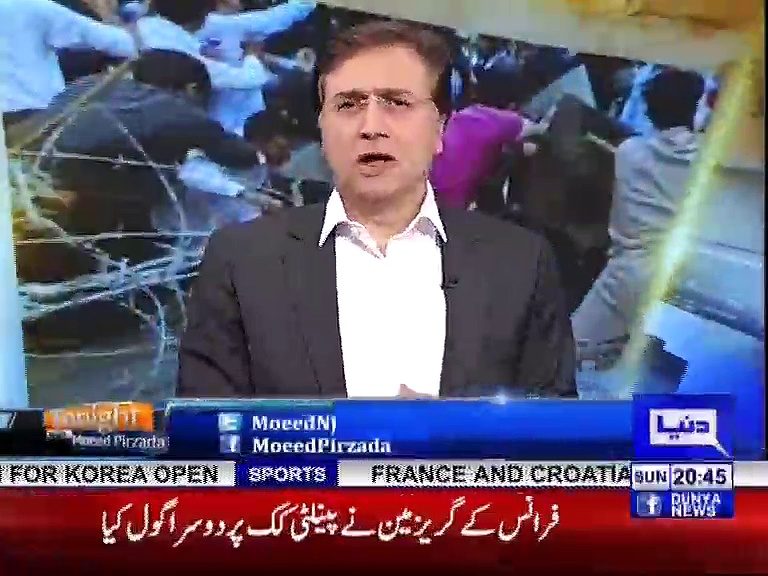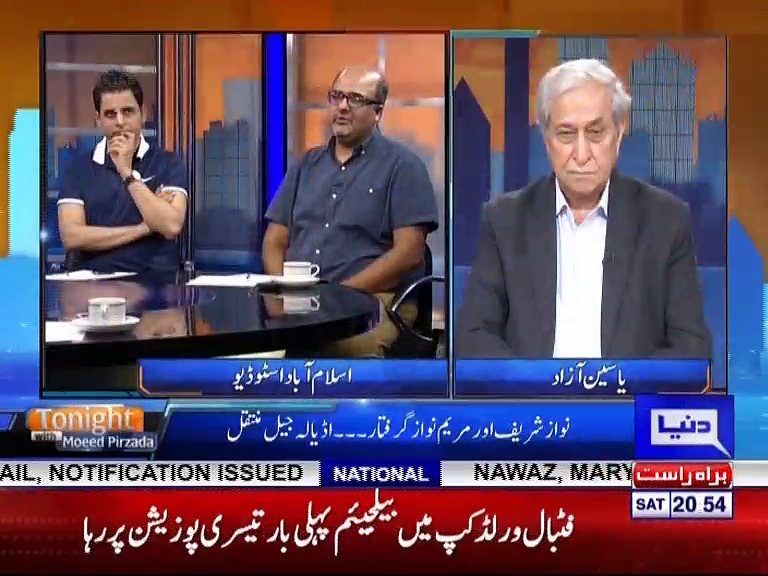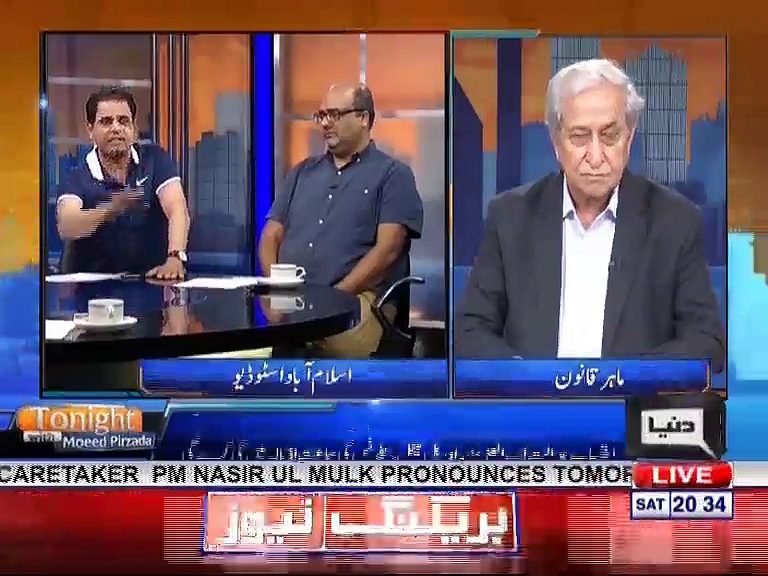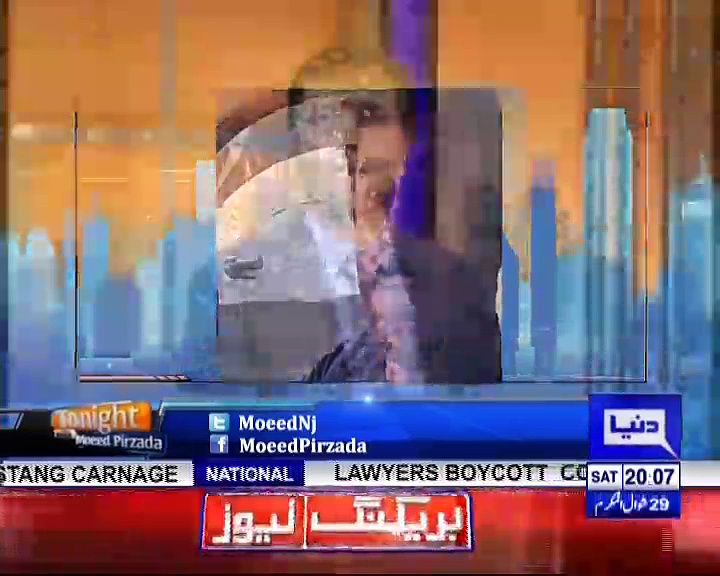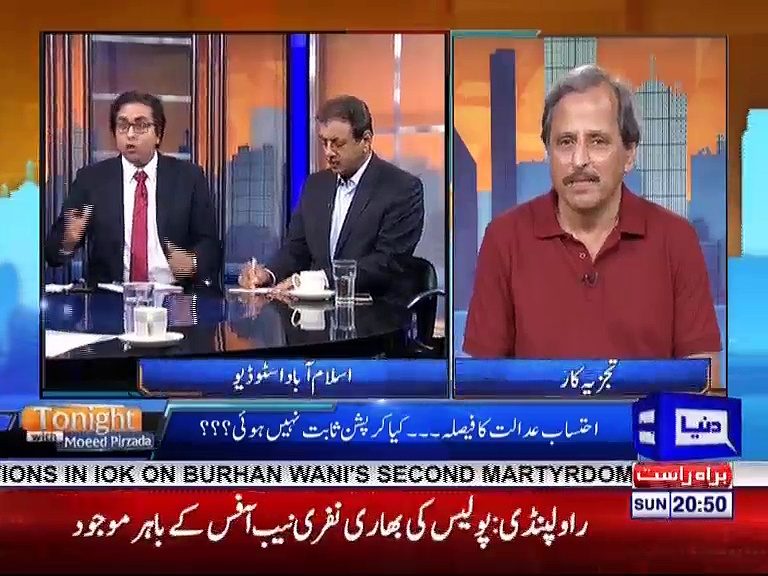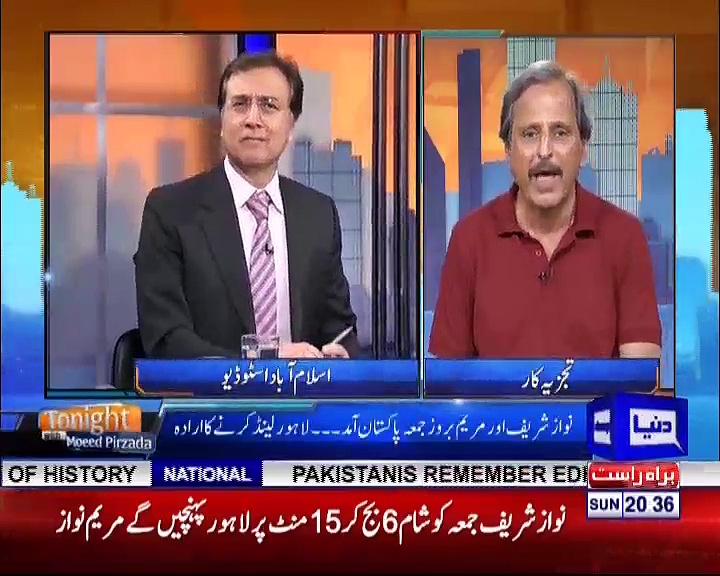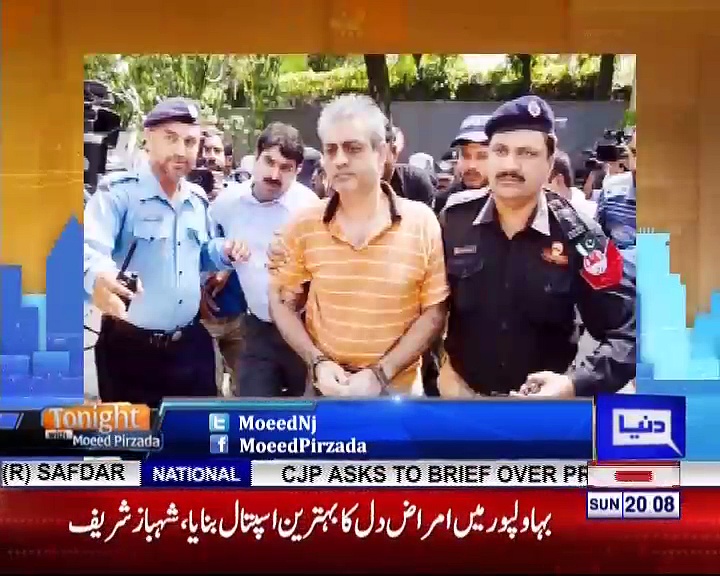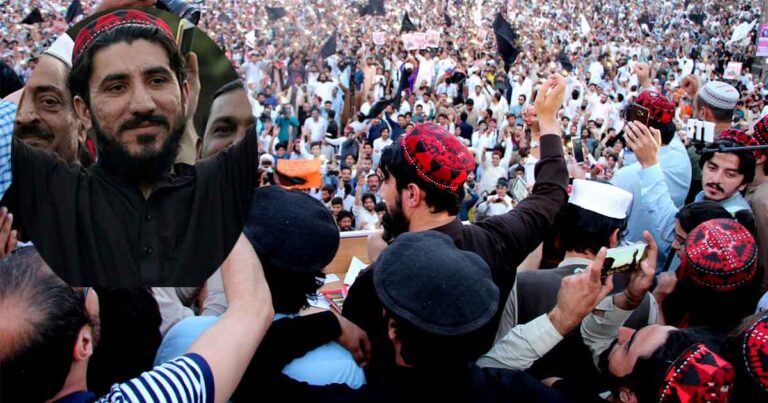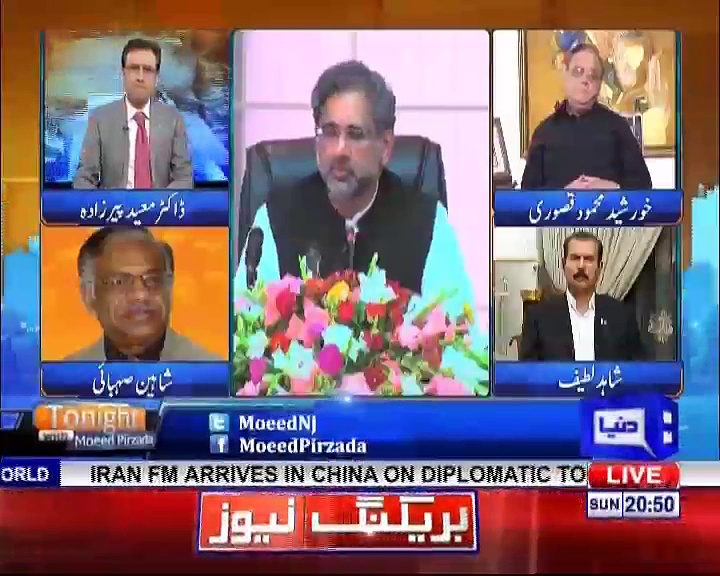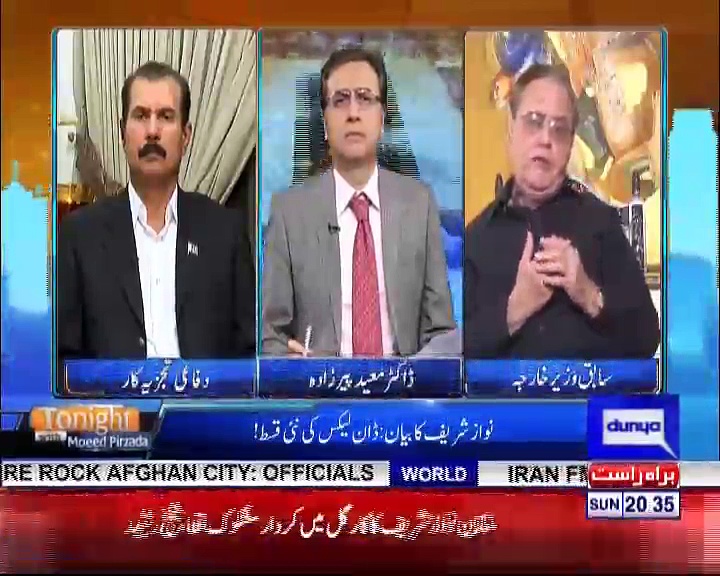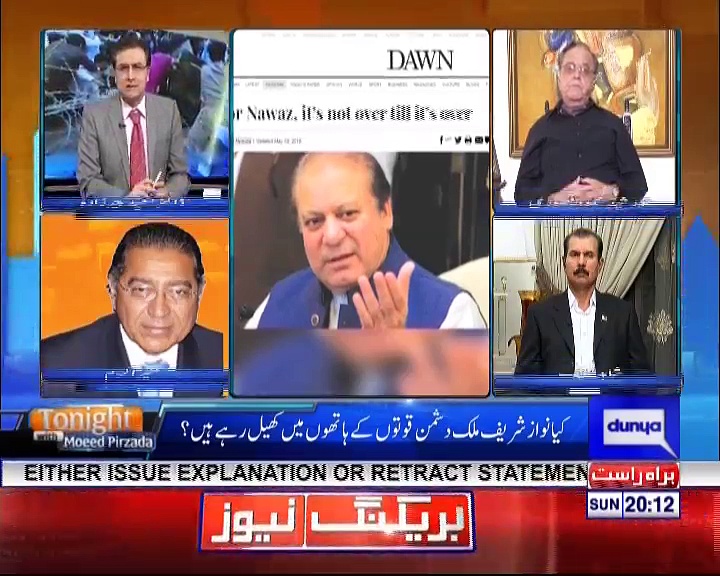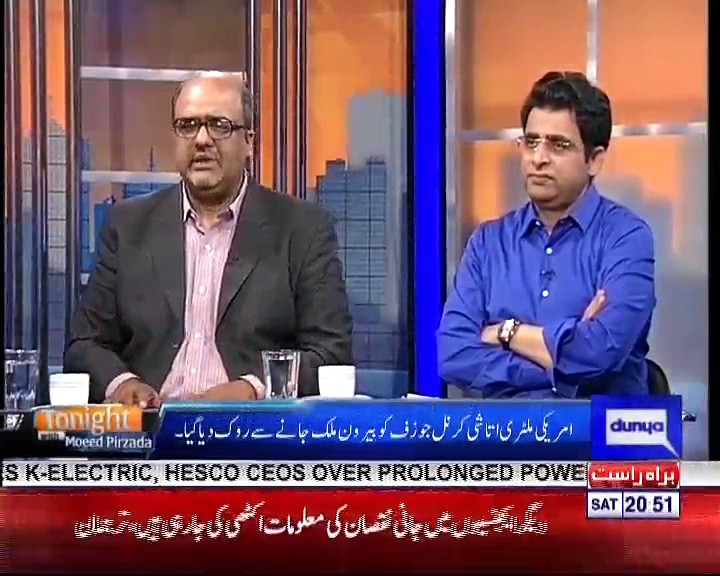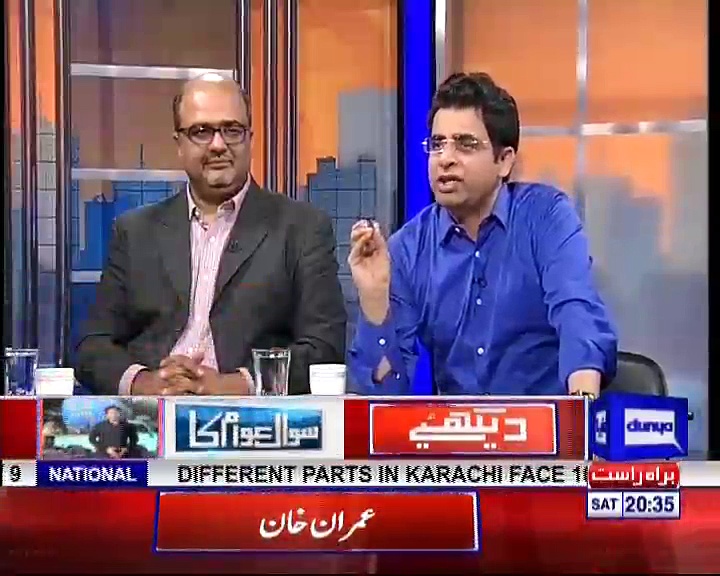Pakistan’s July Elections: Hope Amidst a Difficult History?
Dr. Moeed Pirzada |
Politics often consists of paradoxes and Pakistani attitude towards general elections offers an interesting and perhaps painful example. Pakistani people, rival political parties, institutions and media share an enthusiasm that elections will throw up solutions to their problems though past elections have seldom lived up to their promises and today there is often little agreement on what those problems are. Like Sisyphus’s plight, Pakistanis carry their democratic boulder up the hill, only to be pushed back. Once again July 25 elections mean different things to different political parties.
For Imran Khan’s PTI, which is supposedly the main challenger of the status quo that exists since the 2008 elections (London APC, lawyer’s movement, Charter of democracy, Murree Accord, etc.), this election is about end of dynastic politics, corruption in high places and better governance; for Nawaz’s PML-N (considered dynastic by PTI) this is an election about democracy, civil-military divide and what the world thinks about Pakistan (vote ko Izzat do and burying the debate about corruption and dynastic politics).
Perhaps to those who wonder why the journey towards democracy looks so different in Pakistan from that of India supposedly the other part of same country till August 1947.
For the third main party, PPP, which has brought a manifesto with aspirations of social reform, this is mainly about maintaining control on interior Sindh, re-entering Punjab, (and may be forming a central government in a coalition). For the MQM, this is a struggle for survival, in the increasingly fractious politics of Karachi, where its traditional vote bank is now split between different competing interests and for the Pakistani establishment (often considered the undeclared political party) this represents a battle for national sovereignty from creeping foreign influences, fear of IMF and Pakistan’s economic future – others don’t matter, at least not to the extent of changing the bigger picture.
A coalition of religious parties is attempting to revive the old glory of “Mutahida Majlis-e-Amal” (MMA of 2002) and several religious factions like Milli Muslim League (supported by JUD) are trying to enter the electoral fray directly or indirectly but the public and media have shown little interest in their slogans. Ironically, none of the political parties has shown any serious substantive concern about the real issue underhand; the ‘economy’ and how its myriad challenges will be met after the July elections.
Read more: Elections 2018
For the common man on the street this is about prices of vegetables, food grains, chicken, mutton, goods and services; for the middle classes and businesses, its about the rupee/dollar parity and for manufacturers its about the costs of electricity, fuel and other inputs. Pakistan could not hold country wide general elections on the basis of universal adult franchise till 1970. Provincial elections on adult franchise were held in Punjab, NWFP (now KP) and former East Pakistan in 1950’s often producing results that frightened the ruling elite of the then “Muslim League”.
President Ayub Khan held an indirect election, through an electoral college of 80,000 electors, on the basis of “Basic Democracies (1962-65) though it was believed to be widely rigged. Similarly, 1977 elections were again believed to be rigged by Bhutto and his party, PPP, in order to get the two-thirds majority. 1985 Elections were on a non-party basis, subsequent elections of 1990, 1993, 1997 and 2002 were all engineered one way or the other the only exception to this norm that led to transfer of power was in 2008, which warrants a detailed comment because this was the only election after 1970 in which incumbents were replaced by the electoral process.
Ironically, none of the political parties has shown any serious substantive concern about the real issue underhand; the ‘economy’ and how its myriad challenges will be met after the July elections.
Why the different Election Trajectories in the Subcontinent?
Since the ill-fated elections of December 1970, (that led to civil war, Indian intervention and creation of Bangladesh) this will be the 11th general election of Pakistan on the basis of universal adult franchise and in many ways, it could prove to be decisive for country’s future. India has so far held 16 general elections since 1951-52, however, unlike Pakistan, the history and concept of elections was already much deeper in the areas of the sub-continent that constituted India in August 1947.
Though, formally first Indian general elections were held in 1920, (after the Government of India Act 1919) followed by 1923, 1926, 1930, 1934 and then 1945 and provincial elections on much larger scale were held in 1937 and 1946. However, this school textbook history ignores that a culture of some sort of modern albeit grossly imperfect institutional accountability started to grow in the south of India from the middle of 18th century soon after the Battle of Plassey and defeat of Siraj ud Daulah in 1757.
Read more: Elections 2018 in Pakistan and Afghanistan: Critical juncture ahead?
After the Battle of Buxar in 1764, when the combined forces of Mir Qassim of Bengal, Nawab of Awadh and Mughal Emperor Shah Alam-II lost to East India Company, a new system of governance started to shape around the plains of Ganges, between the presidencies of Bombay, Calcutta and Madras. No doubt officials of East India Company effectively portrayed by William Dalrymple in his writings were often rapaciously corrupt, cruel and self-motivated, but despite all their failing,s they were ultimately part of a remote and rough system of accountability to shareholders, directors and the Crown in London.
By the time Sindh (1842) and Punjab (1849) along with NWFP (now KP) fell to the English, an initial culture of accountants, clerks, lawyers, record keepers, and modern tax collection had taken hold in Delhi and beyond. When Allan Octavian Hume conceived Indian National Congress in 1885, less than 30 years after the War of Independence (or Sepoy’s Mutiny, whichever way you interpret it) he had a nascent culture of modernity around him the likes of Jinnah, Motilal, Gokhale, Gandhi, Chandra Bose and Nehru were all progenies of the same culture originating from the south.
India has so far held 16 general elections since 1951-52, however unlike Pakistan, the history and concept of elections was already much deeper in the areas of the sub-continent that constituted India in August 1947.
Political parties and elections are ultimately a part of western style democracy and modernity; a new process of change that crept upwards in the sub-continent from the south towards the north, reversed the two millennia old tradition of Central Asian horsemen bringing innovations of stirrups, guns and cannons into the plains of the Indus and beyond. Perhaps to those who wonder why the journey towards democracy looks so different in Pakistan from that of India supposedly the other part of same country till August 1947 these differences of history and geography have never been important or obvious. In most instances their single minded focus on “Pindi” and GHQ has prevented the larger understanding of the tyranny of history.
Pakistan more Democratic than its own Neighbourhood?
But despite its many electoral failings, its much talked about democratic deficits Pakistan as a polity is far more democratic, open and plural society than its own neighborhood that extends through Central Asia towards the Middle East. This reality is ignored or misunderstood because comparisons are drawn with its eastern and southern neighbor, India, which in most ways (if we ignore the recent rise of Hindu extremism in the form of BJP) is definitely more democratic, more plural than Pakistan.
But Pakistan’s neighborhood is not merely India; it has Afghanistan, Iran, China in its immediate borders and then the historical and geographical continuum extends into Central Asia, Gulf and wider Middle East. Once you grasp this map (and realize that territories that constitute Pakistan have been part of British India for only 70-100 years) a totally different picture emerges.
Read more: Waqar Younis vows to support Imran Khan in Elections 2018
Why the 2018 elections will be the most important since 1970?
July 2018 elections in many ways will be Pakistan’s most important elections in almost half a century – since 1970; these elections will determine what kind of Pakistan will emerge as a result of the battle between the forces that are now arraigned against each other. This contest is different from all past elections; to begin with there is no one in real control like in 1970. Though it is widely accepted that 1970 elections were the fairest, cleanest elections ever in the history of the country.
However, there is much evidence to suggest that the regime of General Yahya Khan distributed massive troves of cash to political parties in West Pakistan to weaken chances of Bhutto’s PPP and to stem the tide of Sheikh Mujib’s Awami League in the eastern wing and counter India’s deep penetration– none worked. The Government in Islamabad had actually less and less control on the dynamics on the street, instruments of law and politics in its eastern wing after January 1970 – and in the western wing, slogans of “Roti Kapra aur Makan” played havoc in the minds of all those teeming millions who had been deprived of growth in the 1960’s crony capitalism.
Pakistan’s neighborhood is not merely India; it has Afghanistan, Iran, China in its immediate borders and then the historical and geographical continuum extends into Central Asia, Gulf and wider Middle East.
When a political game of musical chairs was being played out between 1988 and 1997, with first Benazir and then Nawaz thrown out in turns by President Ghulam Ishaq Khan (supported by the then establishment) it was always clear that one who has been kicked out will not be coming back. The interim governments that were set up in 1990, 1993 and 1996- 97 were thus clear as to what was expected of them, and what kind of results they had to produce.
In the June issue of Global Village Space, Asim Imdad Ali, a former senior District Management Officer (DMG) explains the dynamics, of election management on a macro level and how the machinery police, district administration, Election Commission, Education Department officials, etc. perceive who will win and play their part in ensuring the desired outcome. The local notables, sometimes described as “vote managers” of important constituencies, too act inside a clear system of belief, a visibly perceived reality, since they are financially and politically invested in the outcome and a wrong judgment as to who the winner will be can deprive them of their access to centers of power for the next several years.
Read more: Elections 2018: A massive political exercise
The outcome of the 2013 elections in which status quo parties won everywhere in Punjab, Sindh, Karachi, and Baluchistan – except KP can be easily understood in the context of these power dynamics. PML-N had been ruling in Punjab and PPP in Sindh since 2008, MQM controlled all levers of administrative power in Karachi since their Faustian bargain with Musharraf in 2002; two-month interim set up of 2013, was thus a convenient smoke screen, a cosmetic cover to the actual power dynamics wielded by the political parties PML-N, PPP and MQM – on the ground and results often described by local and international media, governments and donors as a transfer of power in a romantic facade of democracy were plainly misleading.
PML-N that effectively controlled the bureaucratic and administrative machinery in Punjab, from March 2008 onwards, not only won Punjab but by virtue of its control on Punjab ended up controlling the center. (Punjabi bureaucracy had the additional fear that PML-N might have been able to form the government anyway) The argument given by all those who benefitted from this outcome was that PPP lost the center and PML-N won because the public had realized that PPP had not delivered. But the PPP had not even delivered in Sindh, the only difference was that it controlled the administrative levers and thus the minds of “notables” and “vote managers” in Sindh and had no influence whatsoever in Punjab.
The interim governments that were set up in 1990, 1993 and 1996- 97 were thus clear as to what was expected of them, and what kind of results they had to produce.
Why 2008 Elections stand out?
The electoral outcome of May 2013 was in marked contrast to that of Feb 2008. Then, the PML-Q, the incumbents in Center, Punjab, Sindh and Baluchistan lost in all the four places to the PPP, and PML-N who came from outside the power corridors. 2008 elections were thus a rare, perhaps the only, example of a sitting government, the incumbents, losing out to challengers a real transfer of power. But even that is easily explained by the fact that Musharraf, in understanding with the US administration, was trying to stay on as President with the support of the PPP.
He was given assurances through the broader deal built into the infamous NRO and there is reason to believe that his supporters in Washington had made it clear that a PML-Q victory will not be acceptable. Musharraf was thus willing to sacrifice his political contraptions for his own continuation as president till 2013 it did not work, when Nawaz supported Zardari (with tacit support from Washington) to get rid of him which is another chapter. The Chaudhries of Gujrat and other ex-leaders of PML-Q, some of whom later joined PML-N have been sharing these juicy details, these hints and sometimes conversations with whosoever wanted to cross examine their stories and their plight.
Read more: Elections 2018: Who is winning & how much?
Electoral Reality of the two Contenders
None of these certainties, of the past, the days of easy predictability, now exist. No one is in full control of the administrative system and the overall picture is mixed. Nawaz, the former Prime Minister, was thrown out, by the Supreme Court, (which had in July 2017, no other option) under tremendous political, media and public pressure stirred by Panama papers scandal. His expectations of deriving support from a JIT dominated by Army officers failed though his approval of JIT was predicted upon his assessments that he will be able to bail himself out this way through a compliant and unsettled new Army Chief.
Once the Army did not bail him out, he cleverly shaped a media narrative that the whole Panama case (and corruption of his family) was the Army’s creation, he even for a short while tried saying it was a Western conspiracy against him to sabotage his vision of CPEC. But after the initial setbacks he played well; most of his party is intact, he sold his slogans Mujhay keon nikala & Vote Ko Izat do well, displaying a deep penetration into country’s large print and electronic media and the generation of current police and district officers across Punjab swarm with his loyalists, giving him tremendous influence on the outcome of the coming elections.
The PPP had not even delivered in Sindh, the only difference was that it controlled the administrative levers and thus the minds of “notables” and “vote managers” in Sindh and had no influence whatsoever in Punjab.
Most of the western media and perhaps key western governments along with a political establishment in Delhi support Nawaz as an instrument against Pakistan’s establishment. He has been selling himself since 2013 or perhaps earlier to the western world as an antidote to the Pakistani military, strategic community and nationalists and as someone who understands the imperatives of accepting New Delhi’s suzerainty over Pakistan.
Many amongst his supporters believe that PML-N will still be able to win around 80 seats from Punjab and Begum Kulsum Nawaz’s state of health about which a carefully controlled mystery exists – will be used to thwart the Accountability court process, and a possible conviction in the corruption case of ‘Avenfield Apartments’ and for generating a sympathy wave, days before the elections. Courts have been ridiculed so consistently by media, supporting Nawaz, that they are visibly on defensive and unable to take decisive actions to enforce the writ of law.
Read more: Elections 2018: Pakistan’s dirtiest elections or the fairest?
So while general elections are only 25 days away (by end June) accused can still endlessly dodge the court process through fake or questionable medical certificates. Perception of power and control matters and for the first time since 1970, total uncertainty prevails in the minds of administrative machinery about the outcome of July Elections. Asad Umar, PTI leader tipped as next Finance Minster by Imran Khan, had recently claimed in a Dunya TV program, that PTI hopes or aspires to win 100 seats of its own out of 272 directly elected seats.
But Prof. Shahbaz Gill, of the University of Illinois at Urbana Champagne, studying Pakistani electoral dynamics on ground across Punjab, gives more specific calculations: he claims that PTI will win from 28-30 seats out of 39 in KP, around 80 seats out of 141 in Punjab, 8 seats out of 61 in Sindh, 6 from FATA and 2 from Islamabad making a total of around 125 by itself clearly in a position to form a government with the help of independents and smaller parties.
If this happened, if his calculations are sound, and a party that is driven principally by the support of educated middle classes like Bhutto’s PPP in 1970 despite its controversial embrace of electables was able to form governments in Islamabad, Punjab and KP, then Pakistan will surely enter in the next phase of its history. But the future like history is unpredictable; there is many a slip twixt the cup and the lip and whether Pakistan will remain wedded to its history of “Democracy Sans Democracy” like King Sisyphus of Greek mythology or will move beyond it will become clear in the morning of July 26.
Moeed Pirzada is a prominent TV Anchor and Editor Strategic Affairs with Dunya News Network and a known columnist. He previously served with the Central Superior Services in Pakistan. He studied international relations at Columbia University, New York and Law at London School of Economics, the UK as a Britannia Chevening Scholar. He has been a participant in Chaophraya Dialogue, has lectured and given talks at universities and think tanks including Harvard, Georgetown, Urbana Champaign, National Defense University, FCCU, LUMS, USIP, Middle East Institute and many others.
Spy Chronicles: Chronicles of Durrani, Dulat, Nawaz & Rabbani..
Moeed Pirzada |
“When it was published, I think, during my period, someone came and said, look what’s written, what should we do? Should we get hold of the man, court martial him, issue a rebuttal? I said, there must be 20 people who have read it, but once we do something, 200 people will read it”
Spy Chronicles – RAW, ISI and the Illusion of Peace, Page 36
Gen. Durrani was talking to Aditya Sinha, Indian journalist and author of “Spy Chronicles” during one of their conversations when Aditya had referred to “Afghanistan The Bear Trap: Defeat of a Superpower” – a book written by Brigadier General, Muhammad Yousaf, of Pakistan Army and Major. Adkin, a British officer on the covert war ISI and CIA fought against the Soviet Army in 1980’s. Bear Trap was first published in 1992 when Gen. Durrani headed ISI. Durrani, while remembering the “Bear Trap” saga may not have realized that soon his conversations with AS Dulat, being recorded by Aditya, will bring him to the threshold of a court-martial. He always had a belief in the deeper wisdom of his own institution.
At another point, in “Spy Chronicles” when Aditya asks him if ISI has ever objected to his meetings with AS Dulat, Ex-RAW Chief, he tells him that no one has ever asked or cautioned him; “all our institutions, civil or military may have had confidence in my ability to hold my own” and proudly asserted: “we have never suffered from paranoia on such matters”
So the man who had thought that Brig. Yousaf’s “Bear Trap” represented an agenda but decided to ignore it for he did not want to increase its popularity and who thought he enjoyed the trust of his civil and military institutions must have had a rude shock when he was summoned back to General Headquarters (GHQ) 25 years after his retirement, was put on Exit Control List (ECL) and was told that he now faces a formal enquiry, headed by a serving Lt. Gen. for violating Army’s Code of Conduct.
Read more: Spy Chronicles: A one-sided narrative
Pakistani “Officer & a Gentleman” vs Indian Intelligence Czar?
“Spy Chronicles” grew out of the series of discussions, between Durrani, Ex-DG of Pakistan’s Inter-Services Intelligence (ISI) and Amarjit Singh Dulat, former head of Research & Analysis (RAW), India’s external intelligence agency – faithfully recorded by an Indian journalist, Aditya Sinha. The idea grew out of their Track-II interactions, over the years; discussions were carried in different parts of the world – mostly in Bangkok, perhaps over “happy hours”– between 2016 and 2017 and book was formally launched in the third week of May 2018.
Book’s pdf version was immediately available, which may have been a marketing trick by the publishers, but its wide circulation through WhatsApp and Email, two months before Pakistan’s general elections, sparked suspicions that someone somewhere is working hard to ensure a wider dissemination. While it certainly represented an interesting initiative – of bringing together former heads of ISI and RAW – it also had its own set of problems. Many quietly observed that book’s emphasis remains on issues Indians want to talk about, with reference to Pakistan, its Army, and ISI and while AS Dulat, an intelligence man all his life, remained cautious and guarded and economical with his words, Durrani – who barely served 18 months in ISI – was generous with long-winded explanations and descriptive details on an institution he apparently did not know much about.
Dulat did not talk much about RAW or IB’s workings or their range of interests, dodged most pointed questions and successfully diverted attention from difficult issues like Kulbhushan Jadhav, Indian establishment – or Deep State as Durrani refers to it – funding $25 million television channels, India’s role in Afghanistan and Pakistani Baluchistan, India’s rightward drift towards Hindutva extremism and its implications for Kashmir and Pakistan and so on.
At one point, when Sinha, perhaps inadvertently, asks the question that where were Kashmiris, in pre-partition India, going to for work? migrating to? Where were their cultural, business and political links? With modern India or modern Pakistan. (P:79) Durrani dealt with this bombshell of a question with a degree of insensitivity, with a sleepy, happy hour mind, barely pointing out that statistics speak and families like Taseers and Sharifs all migrated towards Lahore. Excuse me, Ex-Chief ISI, is this what all history and geography, four wars, countless battles, hundred thousand deaths and thousands of mass graves across Kashmir boil down to? Is this what your Pakistan has always been fighting for?
Is this enough of a description for Indo-Pakistan’s “Core Issue”? Dulat, the skilled Intelligence Czar, alarmed on the fundamental importance of this question, immediately took over describing this as “a question not significant” and then paints a broader picture of Lahore being a cultural center, attracting not only Kashmiris but people from all over Punjab- even his father wanted him to go and study in Punjab University, instead of St. Stephens college in Delhi and after carefully taking charge of the narrative adds that Kashmir’s real historical relations existed with Iran and Central Asia.
Read more: Pakistan military says ex-spy chief will not be allowed to leave…
Dulat’s spin on Kashmir
While most reading anywhere, even in India and Pakistan, would not understand the trick but any Kashmiri could immediately see through Dulat’s hypocrisy – his mental alertness, and his tight control on narrative shaping. A Punjabi, a Pashtun, a Delhi wallah, a Tamil, a Bengali or Hyderabadi – forget about the Europeans or Americans – at the beginning of 21st century would not understand the fundamental importance of this question or the human tragedy encapsulated in it, but RAW’s Kashmir expert knew the catch in Sinha’s stupid or innocent question – perhaps the only real question he asked in these 255 pages.
The historical fact was that Kashmir valley, till 1947, never had any meaningful geographical links with modern India – except through British Punjab. From times immemorial, Kashmir could only be approached – by its lovers, tourists, conquerors, and marauders – from north and west. Srinagar-Rawalpindi road was its only all-weather access. Over hundreds of years, this route kept changing its morphology and micro details, but the elephants of Mughal Emperor Jehangir and the motorcar of Pundit Nehru – both of whom professed love for Kashmir – could enter more or less from the same route. And this was the only real exit from the valley.
The other route was via the Jammu-Sialkot corridor. But Kashmir-Jammu access was not all weather; before partition, Dogra elite used what was called, “Banihal Cart Road”, the route that later in Bakshi Ghulam Mohammad’s time gave way to the famous “Banihal Tunnel” that provided all-weather access between Srinagar and Jammu. Now “Patni Top Tunnel” has further reduced the distance between Srinagar and Jammu, giving India a much firmer strategic hold on the area.
No wonder then that, before partition and all along valley’s recorded history its cultural, business and political links existed with Punjabi towns of Rawalpindi, Lahore, and Gujranwala; the part of India that is now Pakistan- and that is why Taseers and Sharifs headed that way. This is why Lahore mattered and not Delhi, and this is why a population, denied of two thousand years of organic human linkages, feels itself hypoxic, imprisoned and trapped inside the body politic of an India fast becoming a Hindutva realm – under the stewardship of Modi and Doval. And that is why Kashmiri youth flutters in agony, sings in unison, demanding “Azadi.”
Read more: Interior ministry puts ex-spymaster Durrani’s name on Exit Control List
Gen. Durrani’s Faux Pas & Gaffes?
So before the storm hit, Durrani’s ex-colleagues, junior officers, and many in the media who were being exposed to the extracted paras from “Spy Chronicles” via WhatsApp traffic (few reads books, unless they are controversial) were mulling and muttering over his fantastic claims of $ 50 million payments in Osama Bin Laden saga, Kayani meeting Petraeus on a US carrier before the Abbottabad raid, creation of Hurriyat and factually inaccurate references while quoting David Hadley. While his comments regarding the OBL saga and Hadley could be taken as his speculations, his informed or misinformed opinions on developments that happened much later, years after his retirement in early 1993; his comments on Hurriyat were considered most offensive.
Though Kashmiri umbrella group (APHC) emerged, as a negotiating platform, after Durrani had left ISI and had nothing to do with him, but his comments read as if he was taking credit for it. Overall, the feeling was that “our man walked into a trap” without realizing the implications of using his past position. Many were furious, that Dulat very cleverly kept on massaging Durrani’s ego by continuously referring to him as the all-powerful DG ISI– a description and a fantasy more in line with Indian narrative of a rogue, out of control ISI, than the institutional reality inside contemporary Pakistan.
DGI interacting directly with CIA may have that kind of awe, during the Afghan war of 1980’s, its hangover may have continued in 1990’s but Indian references towards ISI – abundantly on display throughout the book – are like the American references towards Iraq’s ill equipped Republican Guards, building an exaggerated persona before targeting them – and claiming huge credits for an otherwise easy victory.
Most aware Pakistanis now do realize that Indian agencies, since 9/11, have shown their capacities of imposing a 4thor 5thgeneration warfare upon Pakistan by engaging disparate elements; be it the religious fanatics of TTP, Baluch insurgents, MQM militants, urban criminal gangs of Karachi (likes of Uzair Baloch) the overambitious elements inside Pakistani media or the operatives of NDS in Kabul and Herat. At certain places, Durrani even points out, that Indians underplay their capacities and exaggerate those of Pakistan but he still failed to stop Dulat’s strategy of endlessly flattering him as an “Intelligence Czar”
But books have Agendas & Mistakes!
But irrespective of all these series of disappointments, and some obvious misstatements by Durrani, no one – before Nawaz & Raza Rabbani barged in searching for moral equivalency – could have come out with blazing guns against him or the book; Durrani was right in a way that Pakistan had moved from that paranoia of the past, civil and military institutions and the media have trusted his moderate, informed and sane voice. Many in the media were fascinated by this old man, 80 plus, who drives his own car, an old station wagon, struggles to find parking spaces unlike some of his colleagues who may be known for their swanky land cruisers, expensive properties and the army of servants.
Almost everyone understands that Durrani is a respected sane analyst, an active Track-II, globetrotter who watches less of TV but reads more and remains updated and informed. “Spy Chronicles” after all is only a book between an Indian officer retired almost 15 years ago and a Pakistani leading private life for past 25 years and Durrani has merely expressed his opinions, his speculations; those who have read the book cannot find anything like a “state secret” being spilled, or any intention to harm the country.
And Durrani at places impresses his Pakistani detractors by his command of issues inside Afghanistan, his understanding of fault lines with the US, and his critique of the Deep state in India and the US. He is, for instance, unambiguous in asserting that the US deep state does not want to leave Afghanistan; they want to hang on to their bases, to keep a watch over Pakistan, China, and Iran and they want to maintain a state of conflict to justify their presence. So what went wrong? What emboldened the hush-hush rumblings into a storm? How this respected man, this co-author of an interesting book, ends up on Exit Control List in a country where books of Salman Rushdie can also be found, quietly eating dust, on shelves of bookstores and libraries?
Read more: Pakistan’s Civil-Military Relations: Internal Battlefronts Exposed from Media Leak
Nawaz’s Sharif: Center Piece of Indian Narrative?
None of Durrani’s critics were strong enough or determined enough to target him or “Spy Chronicles”; the attack on him – that finally earned him an unexpected invitation from GHQ – came from an unlikely combination, an unholy alliance of two men: One, Nawaz Sharif, who has probably never read a book in his life and the second, Senator Raza Rabbani, a learned man who speaks with conviction (most of the time) has even written books but who was batting for Nawaz. What is Nawaz’s problem? And how he fits into all this – unwittingly creating a crusade against a book – is an interesting chapter of Indo-Pakistani history.
On 16th April 2016, an interesting and a ferocious tv debate was taking place, on Times Now, an Indian TV channel. Panama Scandal had just hit the fan, somewhere in the first week of April, Nawaz Sharif, his sons, and daughter were under attack by the opposition in Pakistan and the Indian and Pakistani participants of this program were fighting each other, with raised voices on the implications of Panama Leaks for Nawaz Sharif. Maroof Raza, an Indian defense analyst, who appeared very concerned with Nawaz’s fate was heckled by a Pakistani from Islamabad as to why Indians are so concerned with the fate of Nawaz. It was a shouting match going on, the kind of one in which you lose the end of caution; Maroof Raza shouted back:
“We are concerned with the issues in Pakistan, because our government has invested in Nawaz Sharif, it has invested a lot of political and diplomatic capital in Nawaz Sharif and if Nawaz Sharif is moved out of narrative, then the entire narrative changes”. – Times Now, 16 April 2016
On the face of it, this could be an innocent political comment, from someone who is not a minister or government functionary but only an analyst; however many in Pakistani media, strategic community, military, professional circles and academia, after 2013 elections, had been slowly coming to this conclusion that New Delhi’s political establishment – and Indian media that aligns with Delhi’s foreign policy goals – is invested into Nawaz Sharif and is hostile towards other Pakistani parties like Imran Khan’s PTI, but Maroof Raza’s words – If Nawaz Sharif is moved out of narrative then the entire narrative changes – uttered in a state of “agitated honesty” provided the much-needed clarity to Pakistani analysis of what is building around them.
Nawaz’s own actions, after 2013, had provided support to this thesis that something more than a mere “desire for peace” is at work. With every passing day, every new political development (Avoiding APHC in Delhi, Meeting Jindals instead of Kashmiri leaders, Uffa Declaration in Russia, Modi’s sudden unplanned dash to Lahore, mysterious Pathankot, Nawaz’s reaction to Pathankot, deafening silence on insurgency in Kashmir, inability to capitalize on Kulbhushan Jadhav arrest from Baluchistan, Sartaj Aziz locking himself in his hotel room while Sikh protesters waited for him at Golden Temple, Nawaz meeting Indian businessman, Jindal, in total privacy, on Murree hills, Dawn Leaks and so on) between India & Pakistan, it started to become more and more obvious that Nawaz – perhaps for the first time in Pakistan’s history – feels that his road to power in Islamabad passes through New Delhi.
Pakistanis have long accepted, albeit grudgingly, that Washington’s seal of approval is needed for regimes in Islamabad, but will governments and leaders in Pakistan now be approved, regulated and supported from New Delhi? Is Mughal Hindustan reenacting itself for its Punjabi Suba? Will Sharif family be a dynasty of “Punjabi Subedars” ruling over a “vegetative state of Pakistan” in the interest of Delhi? Is there a new regional paradigm in place with Washington’s blessings in which Pakistani prime ministers will be like Hasina Wajid of Bangladesh and Mehmood Abbas of Palestine? If independent Pakistan has to be turned into South Asia’s Gaza Strip, then it must be emasculated and denuclearized with Pakistan Army turned into Punjab Police; these and other questions have slowly dominated the thinking minds across Pakistan. Ironically, Amar Singh Dulat in his introduction (P: 11) in “Spy Chronicles” writes regretfully that “Nawaz Sharif, man India had put its faith in” will be kept out of power.
Read more: Nawaz Sharif takes credit for making Pakistan an atomic power: issues…
Nawaz: Mir Jaffer of Bengal or Reincarnation of Punjab’s Adina Baig?
While Nawaz’s political enemies have often called him a Mir Jaffar (who was made Ruler of Bengal by English East India Company, after he betrayed Nawab Siraj ul Doula in battle of Plassey in 1757, or Mir Sadiq (who betrayed Tipu Sultan during the 1799 English siege of Sarangapatnum, now “Srirangapatna, Mysore”) he may be better understood as a reincarnation of “Adina Baig” – an 18thcentury, Punjabi Subedar in post-Mughal Punjab. In the period, after Aurangzeb’s death, that saw the collapse of central authority, Adina Baig was the only Muslim Punjabi Subedar who ruled Lahore and surrounding areas first with the help of Afghans from the north, then neighbouring Sikhs and finally Marhattas (primitive face of modern-day Hindutva) from the South.
But has central authority collapsed between Khyber and Amritsar? Can Pakistan’s deepening “Civil-Military Divide” and the narratives – of ethnic insurgencies, urban chaos, failure of governance – that are being shaped around it will lead to a situation, roughly similar, to the 18th century, in which Pakistan’s “center of gravity” disappears.
Analysts of the day may reject this theorizing altogether or argue that Nawaz and those who have invested into him – politically and diplomatically – have misjudged the mood or the timings, but final verdict on this transnational reginal conflict will be given by historians.
So when Nawaz gave its latest interview to Dawn on 12th May, raising an out of context question: “why we allow militants to cross-border and kill 150 people”? he had a long history behind him. And it was immediately understood that he was playing to the galleries in Washington, Delhi, and London and not to Pakistani electorate. Whether Washington and Delhi can bail him out from his legal woes or save him in forthcoming elections is questionable but his comments – and their implications – certainly did not go well with the voters and electables across Punjab.
Realizing the political damage, he is since then trying to equate his actions with all others in order to create a moral equivalency. His supporters in media and twitter warriors remind public that Musharraf, Zardari and Imran Khan have said similar things; deliberately sowing confusion by fudging the facts because whatever comments they offered were while defending Pakistani position during interviews on Indian or other international media. Nawaz’s Dawn interview, on the other hand, appeared out of context and sounded like an “Interview on Demand” in which paper appeared to be obliging him (for sending a message) rather than seeking to hear him.
After Musharraf, Zardari, and Imran – Durrani was thus the latest victim of Nawaz’s struggle for moral equivalency. His argument supported by Senator Rabbani was not related to the content of the book, “Spy Chronicles” but to the very interaction between Pakistan’s Ex-Intelligence Chief with Indian head of RAW. The gist of the argument adopted by Nawaz & Rabbani duo was that, “if a civilian had done something similar then heavens would have fallen” and that relations between India and Pakistan are tense and security situation is so precarious and how could these men even meet or write a book. Nawaz’s complex background, his need to salvage his political position and his desire for moral equivalency can be understood but Senator Raza Rabbani’s ill thought out position was a sad moment for a man of letters and principles.
Read more: Why Spy chronicles’ won’t rescue Nawaz?
Hundreds of Pakistani civilians – politicians, ambassadors, civil servants, ex-Army officers, corporate leaders and media persons- have met and debated issues, (often in heated arguments) under the ambit of Track-II, with their Indian counterparts since 9/11. Pakistani Think Tank, PILDAT, lead by prominent civil society member Ahmed Bilal Mehboob, kept on taking airplanes full of Pakistani politicians, parliamentarians and media persons to India for dialogue. When Fehmida Mirza was Speaker National Assembly, there was the talk of dialogue between speakers of parliaments in both countries. In many instances, they developed joint declarations and wrote policy papers together. On occasions, Pakistanis were requested by their Indian interlocutors not to make public their interactions for fear of backlash against them in India.
Aitzaz Ahsan, a prominent politician, and ex-Interior Minister, wrote a joint book with Lord Desai to great acclaim; Sherry Rehman, Rabbani’s prominent colleague in Senate, has remained active in Track-II dialogues; her think tank, Jinnah Institute, has taken lead in organizing the “Chaophraya Dialgoue” – named after a river in Bangkok – to which “Spy Chronicles” is also linked – this book edited by Aditya Sinha is after all merely a paper manifestation of the Track-II process, that had been going on for years; between a Durrani, retired 25 years ago, and Dulat retired almost 15 years ago – almost non-entities in political terms. If Nawaz is so fond of joining their ranks then he should formally retire from politics, join a think tank or university, read books, write policy papers and make all kinds of speculations – no will take him seriously.
This piece by Moeed Pirzada is being published under the title, “Spy Chronicles: Under Lens of Pakistani Politics” in the forthcoming June issue of Global Village Space, Magazine (print edition).
Moeed Pirzada is a prominent TV Anchor and Editor Strategic Affairs with Dunya News Network and a known columnist. He previously served with the Central Superior Services in Pakistan. He studied international relations at Columbia University, New York and Law at London School of Economics, the UK as a Britannia Chevening Scholar. He has been a participant in Chaophraya Dialogue, has lectured and given talks at universities and think tanks including Harvard, Georgetown, Urbana Champaign, National Defense University, FCCU, LUMS, USIP, Middle East Institute and many others. The views expressed in this article are author’s own and do not necessarily reflect the editorial policy of Global Village Space.
Pashteen’s PTM: A ‘Rights Movement’ or a new ‘Regional Agenda’?
Ahmed Khan, (not his original name) waits in his car behind a long line of other vehicles, for his turn to be checked. He can spot army soldiers with smart tablets putting in CNIC numbers of motorists for verifications. They are probably connected with NADRA records, he thinks. After more than 30 minutes, of increasing frustration, he reaches the point and was asked to get out for a physical body search. He finally managed to cross the check post in about 45 minutes.
Ahmed, originally from a rich SWAT landed family and traveling from Islamabad was furious. He was not alone, many others described similar scenes. This was a few days after a suicide bomber blew himself at Army’s sports unit, in Sharifabad, in Kabal Tehsil of Swat killing 13 soldiers including a Captain. The attack in the first week of February was worst since 2013 and brought back memories of TTP’s reign of terror.
It also brought back those check posts that dotted the landscape of SWAT after the army operation of 2009. Ahmed, the traveler from Islamabad, was not alone, for feeling the way he felt. Hundreds of others soon took to protesting, a tribal Jirga threatened a strike and local MNA, PTI’s firebrand, Murad Saeed, took up the issue in the parliament. Check posts disappeared – replaced in many instances by Aerial Drones that silently hover over the heads.
Manzoor Pashteen in Swat, Why?
On Sunday, 29 April, Pashtun Tahafuz Movement (PTM) supporters, led by Manzoor Pashteen, staged a rally in a Kabal ground attracting almost 5000 people. Local sources describe Pashteen speaking only in Pashto, to a crowd that had less than 500 locals (from within 15 Km radius); he thanked all those who have traveled, on his call, from Kohat, Zhob, Qila Saif Ullah, DI Khan, Swabi, Bannu, South Waziristan and even Quetta.
Pashteen’s supporters traveled in at least 270 vehicles, mostly coasters, counted at Dargai check post located near the Dargai fort. Local politicians claimed that they had told the administration to not let outsiders enter Swat (enjoying peace and tourism) in such large numbers from outside but their protests were turned down.
From “Boom Boom Afridi” to Gen Tariq KKhan who fought in tribal areas, as IGFC, and headed Pakistan’s first Strike Corps at Mangla, Pashtuns are an integral component of Pakistani mosaic.
Pashteen and others including Mohsin Dawar spoke about extrajudicial killings, missing persons and mistreatment of Pashtoons in Pakistan. Strong words were uttered against the army which itself has a huge component of Pashtoons. Rally was mostly a function of the support it had from Mehmood Khan Achakzai’s “Pakhtoon Khwa Milli Awami Party” (PkMap) whose local leader, Khurshid Kakajee, Senator Usman Kakar and KP President, Mukhtar Yousafzai also addressed the crowds.
One day earlier, on Saturday, another large rally was organized, in the Grassy ground (Cricket Stadium) by a local movement which calls itself, “Pakistan Zindabad Movement” supported by local MPA, Abdul Hakim, and Abdu Rahim, leader of the Traders Association Mingora. Local politicians with representation in parliaments of KP and Islamabad see Pashteen’s PTM as trouble makers working on foreign agenda.
Local elite vividly remember TTP’s reign of terror and are grateful for peace in Swat, that has brought increasing investments and tourism and are worried that this disruptive political activity in the name of “Rights movement” may drive away tourists that flock Swat and its several adjacent areas in three months of summer starting from June.
Who is financing PTM?
A PTM supporter claimed that local elite who organized “Pakistan Zindabad Movement” and its rally are stooges of establishment and Saturday rally was financed. Criticism is valid, since holding political rallies is expensive. But this raises the question: who financed Manzoor Pashteen’s rally and why? This question becomes even more important because its apparent that Pashteen had no local support, in Swat; he brought his followers from far-flung areas – as he admitted himself – at great expense.
Why? This 27-year old’s grievances – admittedly genuine – are centered on issues inside the war-battered South Waziristan, where he belongs to one of the tribes (Mehsud); why is he turning that into a generalized Pashtun victimhood all across the country? Issues in Swat, as locals point out, are very different from South Waziristan.
TTP’s reign of terror, of public executions and floggings, of Khooni Chowk, was quickly routed by Army action in the summer of 2009 which saw one of the biggest heliborne operations, through attack helicopters, in recent history, around Peochar, a hill resort near Mingora. Several hundred young Taliban fighters were killed, unaccounted dead bodies kept floating in river Swat – many still counted as “missing” by their families.
There were reports, and even unconfirmed videos, of extra-judicial killings especially after some SSG commandos were beheaded by TTP after abductions – but the issue died then in 2009. Army check posts were troublesome to the local population but were gradually removed. Life returned to normal with civilian administration, police, judiciary and investments.
In recent years’ tourists have thronged Swat, with such vengeance that it often creates road blockages. However, Swat Expressway kick-started in September 2016, with an estimated capital investment of Rs. 40 billion, is about to be completed; 81 km long, 80 meters wide, the highway will connect areas in Swat with Islamabad-Peshawar motorway and increase connectivity all over as it stretches from M1 motorway to Chakdara; passing through Nowshera, Swabi, Mardan and Malakand.
It will reduce the three-hour travel time to just 45 minutes. The road will be 80 meters wide and will reduce a three-hour travel time to just 45 minutes – giving a huge boost to trade and economy in the region all-around Swat. What bothers Swat’s intellectual elite is the lack of an effective criminal justice system; those who still remember Swat of the pre-1969 merger with central legal authority, point out that local western-style courts fail to deliver.
But all this is very different from the hot molten lava of a wounded Pashtun nationalism which PTM is trying to sell to disaffected communities of Pashtuns wherever they may exist from Waziristan to Lahore to Karachi.
Under Wali of Swat, a quarter-million population spread over 8000 sq. Km area, had access to 32 Tehsil Courts headed by Qazis that provided for swift, inexpensive justice that was rapidly implemented by the state authorities. Currently, an expanded population, two million strong, is being served by 12 police jurisdictions and modern courts that are often marred by inefficiency, lethargy and corruption delaying justice.
Local elites point out that failure of the criminal justice system and inability to resolve property and personal disputes is what had created the space for the Taliban to enter with their promises of quick justice – and those issues still exist. But all this is very different from the hot molten lava of a wounded Pashtun nationalism which PTM is trying to sell to disaffected communities of Pashtuns wherever they may exist from Waziristan to Lahore to Karachi. Swat has obviously not been a success in this endeavor but its struggle continues and much has to come.
Pashteen’s Little Heard Meeting with DG ISPR?
DG ISPR (Inter-Services Public Relations) office located in Pindi, not far from the British Era Hotel Flash man, received an unusual call on Feb 8. It was from Manzoor Pashteen’s supporters, then doing a protest in Islamabad, requesting a meeting with DG. A surprised ISPR team – that had heard little of this “Pashteen” questioned: why Pashteen wants to meet DG ISPR?
How can ISPR help him? PTM supporters – many of whom had previously met ISPR as part of FATA Youth Jirga- requested that he wants to come and discuss his demands in person and this may lead to the end of their ongoing protest in Islamabad – centered around the arrest of SSP Rao Anwar of Karachi who allegedly killed Naqeeb ullah Mehsud.
Consequently, Pashsten and Mohsin Dawar, along with a total of 15 PTM workers or supporters (including many from SWA, verified through their CNIC cards) met DG ISPR. In a meeting that lasted more than 4 hours, they complained of problems in South Waziristan and presented five demands related to: Arrest of the murderer of Naqeeb Ullah Mehsud, Watan Card & harsh treatment at Check Posts, land mines, missing persons and compensations for the loss of property.
During this meeting, they were shown videos of development works across FATA and inter-dependent regions of KP (including: SWA, NWA, Khyber Agency, Malakand & Swat) and were connected on phone with Garrison Commanders (GOC) South Waziristan and North Waziristan and meetings were fixed with them. PTM leaders including Mohsin Dawar subsequently had those meetings, by around 15th of February, and text messages of thanks were duly received in ISPR.

It was a result of those meetings that Watan Card checking was suspended, check posts were reduced, measures were taken to reduce waiting time at check posts, separate check posts for women were promised and efforts are being done to expedite the removal of landmines.
The records of this 4 hours long meeting – and the positions Manzoor Pashteen adopted subsequently – helps us to understand that, 27 year old, Manzoor Pashteen’s movement is less about issues inside South Waziristan and more about shaping a larger agenda – relying upon different changing causes to use them as excuses from time to time.
From the first moment, it has been acknowledged, by almost everyone in Pakistan, that these demands are genuine and they make sense and all issues should be addressed step by step.
But when, in the third week of April, Corps. Commander Peshawar, Gen. Nazir Butt, commented, while talking to media, that he thinks that demands of PTM are genuine – and he wants a Jirga to meet PTM leaders to resolve these issues – many in the international media and think tanks misconstrued that as a great achievement of PTM protests, or rallies, that they are now being listened – ignoring the basic fact that they were being listened even before.
Waziristan: Struggle towards Normalcy
Reality is that the overall political and administrative system of Pakistan, a poor developing country, is under tremendous pressure because of its 15-year-old war against terrorism – ever since it decided to side with the US lead war in Afghanistan after 9/11. Pakistan is the only country that has regained its stability and maintained its center of gravity after the developments of 9/11 – it could have also followed the path of Iraq, Syria and Libya.
It is therefore understood that many new challenges have appeared while winning a difficult war. For instance, land mines were not laid by Pakistan Army but were deployed by TTP and its various affiliates to check the mechanized movement of a regular army that moves with armored personnel carriers, trucks jeeps and paraphernalia.
Hundreds of soldiers and officers succumbed to these land mines often referred to as IED (Improvised Explosive devices) in media. Maj. Gen. Sanaullah Khan Niazi was a famous case that generated global headlines. Locals, however, point out, that when Army allowed residents of South Waziristan to return, in 2015, it failed its responsibility in fully clearing the areas of these IEDs and several children and adults lost their lives.

Army sources assert that removal of land liens is tedious and 100% success is not possible since IED’s drift from actual locations due to rain and winds. But locals have a point and its Army’s responsibility to expedite the removal of land mines. Also, the compensations of Rs. 400,000/house for repair or reconstructions offered by the federal government through Political Agents (PA) were insufficient – and this needs a better and more generous solution.
Having said this, one cannot ignore the context; normalcy and the local residents are returning to these areas after more than 10 years, thousands have died anonymously in these areas in hundreds of battles and skirmishes; Taliban always took away their dead bodies and buried them on their own and many went on to fight in Afghanistan – so there might not be as many “missing persons” or in custody as being claimed.
But all these issues can be addressed professionally one by one – as it happens after the end of protracted wars. Pashteen’s continuing rallies, creating the impression that he is not being heard – despite being in touch with Army establishment on his own request – represent clearly a different set of ambitions. It has also given rise to suspicions that he and his young crowd don’t have a mind of their own but are mere pawns in a larger scheme of things.
All those, who had vociferously demanded army action against Islamist or religious Pashtuns and supported drone strikes and “army action” are now shedding crocodile tears for ethnic Pashtuns. So a full-fledged effort is going on to add muscle, fiber and fabric to the narrative of Manzur Pashteen.
Watan Card has also been misrepresented to media or perhaps misunderstood. Official records reveal that Watan Card was initiated to help the Temporarily Displaced Persons (TDPs) after the 2009/10 operations against TTP in the agencies on the request of the locals of South Waziristan who were displaced from heights and were relocated to low lying areas in Tank, Bannu, Laki Marwat and DI Khan and so on.
Displaced persons were given money (Rs. 12,500/card/month) food and rations and these locals insisted that cards be issued to them to distinguish those who have voluntarily displaced, to facilitate operations, from those who have been living outside the agency on their own. Later, after 2015, the army and FC at their posts started using ‘Watan Card’ as an additional ID card to distinguish locals from those who may come from outside.
Though these cards have been suspended now on PTM’s insistence but it is interesting to point out that most Afghan refugees in these areas have Pakistan’s NIC cards but they don’t have ‘Watan Cards” and this may have led to issues in the area. It is believed by the locals that Afghan refugees constitute a significant support for Mr. Pashteen.
Pashtun Nationalism: Rise & Fall?
Pashtun nationalism in itself is not a new thing. Most areas that today constitute north and northwest of Pakistan made the corridor through which Central Asian, Turkish and Persian warriors – and whatever then constituted modernity – entered the vast low lying plains of Indus and headed south and east down towards Lahore or Delhi.
For the greater part of history, these areas, inhabited by Pashtuns or related tribes, at least up to Indus at Attock, have remained with undefined borders; kingdoms were identified with the cities they held. Afghan rulers of Kabul finally lost Peshawar valley to Sikh rulers of Punjab in earlier 19thcentury. Once Sikhs lost to British, in 1849 – India’s new rulers moving upwards from South – Afghans tried their level best, through war and pleadings, to regain control of Peshawar valley – but lost more territory in every effort.
Most of what constitutes today’s Baluchistan was lost by Kabul in last quarter of 19th century. This is how Baluchistan has large Pashtun population and Mahmood Khan Achakzai represents a certain sentiment – but mostly misunderstood and against the tides of history. Britain developed a modern commercial enterprise in South of Lahore leading to the rise of large metropolises like Bombay, Calcutta and Madras; areas upwards of Lahore were mostly frontier of the British empire.
By 1870’s Rawalpindi emerged as the largest military garrison in British India; objective was to contain threat from north and north-west, present-day KP had no name in British minds except calling it: North-West Frontier Province (NWFP); a term that irked Pashtun nationalists. After British withdrawal, rulers in Kabul thought of renewing the old claims. Afghanistan objected to Pakistan’s membership of United Nations in 1947/48 and encouraged tribesmen in FATA to rise against Peshawar and Karachi.

Tribes guaranteed their freedoms by Jinnah never sided with Kabul. In 1960’s when Sardar Mohmmad Daud became Zahir’ Shah’s Prime Minister he sent troops across the Durand line into Bajaur Agency to stir an insurgency but tribes stood with Pakistan and routed the Afghan forces. Dauod was confronted by another Pashtun, in Pakistan: Ayub Khan.
Field Marshal came down hard against rulers in Kabul, he shut down Afghan transit trade indefinitely creating a crisis for landlocked Afghanistan. Issues were somewhat resolved by interventions of Britain and Saudi Arabia but Daud lost his hold on power mostly for this crisis – and had to resign in March 1963; Pakistan only then resumed normal trade routes for Afghanistan, in May 1963.
Irrespective of these setbacks, NAP (now ANP) of Bacha Khan and later Abul Wali Khan continued feeding on to the dream of a Pakhtunistan; whatever Pakistani establishment did from Karachi or Islamabad it could not suppress the idea. But strange things happen in history.
Pakhtunistan died its death in the Afghan war of 1979-87; confronted by the cultural differences of millions of Afghan refugees, now in their midst, the natives of the then NWFP (now KP) realized that they – in their outlook on life – are not the same people. Pakistani Pashtuns had moved on in the process of history deep into Pakistani identity, whereas Afghans due to their own peculiar experiences had moved in a different direction.
Pashtuns: An Integral Component of Pakistani Identity
Recently a naïve American writer defined Pashtuns as a “suppressed minority in Pakistan”. This is hilarious. Field Marshal Ayub Khan, shaped modern Pakistan from 1955 onwards laying the basis of its industrial structure. Yahya Khan, his successor in power, presided over the end of united Pakistan; Ghulam Ishaq Khan, respected civil servant turned President sacked first PM Benazir Bhutto and then PM Nawaz Sharif and when Nawaz insisted that he will take President along, it was the third member of the troika, Gen. Waheed Kakar, himself a proud Pashtun who fired them both.
Gen. Naseerullah Babar, often credited, though erroneously, for the creation of Taliban was a Pashtun who headed Pakistan’s first civilian lead operation against MQM in early 1990’s under Benazir Bhutto.
From Hashim Khan, to Jehangir Khan to Jansher Khan to Younas Khan to Umar Gul to “Boom Boom Afridi” Pashtun faces have defined Pakistani sports; from Capt. Karnal Sher Khan, Nishan-e-Haider, in Kargil, to Gen. Tariq Khan who fought in tribal areas, as IGFC, and headed Pakistan’s first Strike Corps at Mangla, from Ahmed Faraz to Jamal Shah, from ageless Zeba Bakhtiar to unforgettable Marina Khan Pashtuns are an integral, proud and assertive component of Pakistani mosaic.
From Army, Airforce, Central Superior Services, Corporate Board Rooms to roadside businesses and from talk shows to film and tv dramas, Pashtuns of all accents are a force inside Pakistan. Imran Khan, the most well-known face of Pakistan across the globe, often not referred to as Pashtun, had his mother from Waziristan and father from Mianwali. And it was the tragedy of Army Public School in December 2014, in Peshawar, that defined the national moment towards action against Taliban changing Pakistani laws and politics.
Lar o Bar Yo Afghan?
Is this interlocking embedded identity of “Pakistani Pashtun” now under threat by the antics of Manzoor Pashteen and his mentor Mehmood Khan Achakzai – shouting “Lar o Bar Yo Afghan” (Up and down, we are one Afghan nation; an old ANP era slogan meaning that from up in Afghanistan down in Pakistani territory we are one nation) in rallies and ably supported by US led media and think tanks?
While they may not succeed against the force of history and the strength of Pakistani nationhood, there is much to suggest that something like that is being conceived or promoted under the garb of a “rights movement”. Read Manzoor Pashteen’s twitter handle, connected with his Facebook page, fortunately in Urdu, and you can see that he is far less interested in finding solutions to the local problems and far more interested in inciting strong emotions of victimhood around an ethnicity and thus hate towards perceived aggressors.
But, no record exists of his taking any position against the hundreds of drone strikes that targeted FATA; this is a surprising disconnect, because for most Pashtuns the elephant in the room has been US presence in the region and attacks against Pashtun identity after 9/11. US media and think tank persons have suddenly started to present Pashtuns as an aggrieved helpless minority in Pakistan who are somehow dependent upon PTM to regain their confidence or win rights.

A Kashmiri writer from Srinagar, analyzing the situation, recently wondered if a “Pashtun Spring” is being manufactured; and we know that “Spring Revolutions” originate and evolve less on ground and more on media and cyberspace and sudden interest of publications from New York Times, Washington Post, Foreign Policy to Asia Times Online and many many others points towards systematic efforts to create a “narrative”.
BBC Pashto, VOA –Deeva and France 24 all have been overactive – and all are state funded broadcasters. This is being reinforced by plethora of newer western web sites that are all using different words but more or less the same substance, a consistent message moving from different directions to create and reinforce a mental reality. This is further reinforced by teams of activists connected with NGO’s and international media inside Pakistan.
Most in Pakistani media and the strategic community had seen that video – thanks to WhatsApp traffic; however, it was dismissed as too ambitious and far too diabolical an accusation against the American friends. Tarpley is believed to be a conspiracy theorist. But then anyone who disagrees with the mainstream US narrative is declared conspiracy theorist – and has a funny post against him in Wikipedia.
All those, so-called “liberals” inside Pakistan, who had vociferously demanded army action against Islamist or religious Pashtuns and supported drone strikes and “army action” are now shedding crocodile tears for ethnic Pashtuns. So a full-fledged effort is going on to add muscle, fiber and fabric to the narrative of Manzur Pashteen – it had taken Gandhi and Jinnah several years of struggle before getting this kind of attention.
A respected US think tanker has even suggested in alarming fashion that Pakistan Army may use force against this movement. This is shocking and, apart from unusual interest, represents a “forward development of narrative” – totally disconnected from ground reality. Analyzing this propaganda, Pakistani authorities should instead be worried that any third force may harm any PTM rally or leader to manufacture a crisis inside and around Pakistan.
Short-Term and long-term Implications of PTM?
What can PTM achieve in near future? PTI – sounds different from PTM only for one letter- had won in KP, in 2013 elections, riding on a wave of popularity, a kind of definite shift in politics. While widespread stories of ANP/PPP corruption did help, but it was mostly a Pashtun feeling – in a war-torn province hard hit because of post 9/11 events – for Imran Khan who had taken a strident position against US drone strikes.
ANP and PPP were seen as pro-American and thus not nationalist enough. Both parties were also hamstrung for being in the government and did not have that free hand to take positon on regional and international issues. Now PTM, that sounds very similar to PTI (just like TTP sounded similar to TTA; though very different in motivations) is trying to shape a new kind of “wounded Pashtun nationalism”.
And it is merely using “localized grievances in South Waziristan” disguised under a “Rights Movement” to create a bigger political capital; if it succeeds it can be in a positon to affect the overall direction of politics before the general elections that are scheduled in end July 2018.
PTI having serious prospects of getting around 45-50 seats in Punjab, is now hamstrung and cannot fully identify with a “wounded Pashtun nationalism” – and if it failed to counter the movement, it may suffer in polls in KP. PTM can throw its “political capital” with any player – perhaps decision will lie with Mehmood Achakzai whose main constituency lies in Baluchistan, and had hitherto no serious presence in FATA or KP.
Long-term implications?
In 2014, Webster Tarpley, a controversial American historian, author and analyst, appearing on Russian TV (RT) – Putin’s nemesis for CNN – argued that while President Obama is talking of special relationship with Pakistan, his agencies are planning to create secessionist movements in Pakistani Baluchistan and FATA – to disrupt the possibility of a new energy corridor that can connect China with the Middle East. (CPEC was little heard then).
A bemused, Anchorwoman asked how is it even possible? And Tarpley explained that by agitating Pashtuns living on both sides the Pak-Afghan border and forcing an autonomous area between Pakistan and Afghanistan. Most in Pakistani media and the strategic community had seen that video – thanks to WhatsApp traffic; however, it was dismissed as too ambitious and far too diabolical an accusation against the American friends.
Tarpley is believed to be a conspiracy theorist. But then anyone who disagrees with the mainstream US narrative is declared conspiracy theorist – and has a funny post against him in Wikipedia. Tarpley also claimed, several years ago, that US and Israel are encouraging insurgent groups to split Syria in several parts.
Today, almost all world, outside the transatlantic mental corridor, can readily understand that US, Israel, and Saudi Arabia tried using insurgent groups to dismantle Syrian state and have failed due to the Putin’s unusually muscular intervention. Tarpley’s forgotten video clip, from RT, is now again in circulation, on WhatsApp, focusing minds from Peshawar to Karachi.
The real solution for grievances in FATA lies in its mainstreaming and the best way forward remains its earlier integration with KP. A govt. The commission headed by Sartaj Aziz, adviser to PM, had submitted a detailed report recommending the same. However, despite having a massive demand from all political parties, FATA members and KP government and support from Army establishment, Nawaz Sharif kept dragging his feet.
His argument was that “not without Maulana on board”. So Maulana Fazal ur Rehman and Mehmood Achakzai singlehandedly did not allow FATA merger into KP – thus setting a stage on which now PTM is dancing. And now both Maulana and Achakzai are supporting PTM.
Nawaz – whose daughter recently joined PTM bandwagon – had thus not failed Pakistan on one or two counts but on many fronts. But, then this is what happens when someone suited to be a Mayor of Dina or Kamonkey becomes prime minister of a 200 million strong, strategically important, nation.
